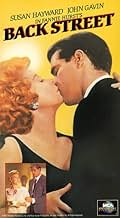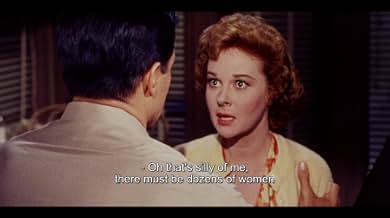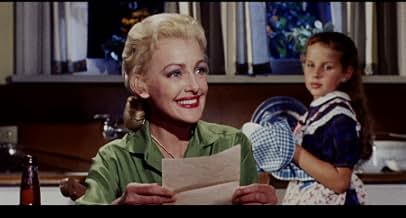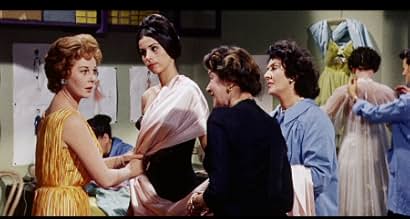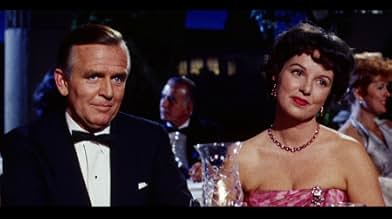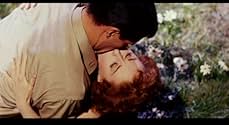NOTE IMDb
6,6/10
1,4 k
MA NOTE
L'histoire d'amour entre l'ambitieuse Rae Smith et l'élégant Paul Saxon débute au moment où celui-ci part à la guerre. Elle durera plusieurs années.L'histoire d'amour entre l'ambitieuse Rae Smith et l'élégant Paul Saxon débute au moment où celui-ci part à la guerre. Elle durera plusieurs années.L'histoire d'amour entre l'ambitieuse Rae Smith et l'élégant Paul Saxon débute au moment où celui-ci part à la guerre. Elle durera plusieurs années.
- Réalisation
- Scénario
- Casting principal
- Nommé pour 1 Oscar
- 1 nomination au total
Joseph Cronin
- Airport Clerk
- (as Joe Cronin)
Avis à la une
I feel a great affinity with Back Street because of the way it shows that a love affair will stay exciting and endure longer because the lovers are only able to be together for short periods of time with long intervals between their meetings. The hum drum aspects of married life never changes their relationship. They are on a perpetual honeymoon. Every time they meet it is exciting and they always look forward to seeing each other. I have often thought that if I had never married my husband and just had a relationship with him like Susan Hayward had with John Gavin over the years I probably would have been happier. She had the best of both possible worlds in my estimation. A wonderful successful career and the knowledge that someone loved her passionately and completely all those years. In addition she could return that love without reservation and enjoy the happiness it gave her to do so. I bet there are thousands of married women who watched this movie and had the same thoughts as I.
Try to understand that 1961 was the dawn of the sexual revolution predicated on the birth control pill; therefore everything in this movie reflects the pre-1961 era when people were often locked into marriages -- good or bad.
This glamorized version opens the story up from simple people in the 1932 and 1941 versions and makes them self-assured, very good-looking, and easy-street rich. This allows the cameras to give us beautiful vistas of Rome, Paris and London --- as they were before the Great Tourist Invasion which began in 1965 when Pan American World Airways broke with the IATA cartel and slashed fares to Europe, allowing folks like us to join the rich and go there. Now I can tell you that Susan Hayward's Paris hotel was definitely the RITZ -- the Rue Cambon entrance -- the back street entrance near the Ritz Bar where Hemingway evicted a rich woman's pet lion by throwing said lion out on the sidewalk.
Under David Miller's able direction, the narrative is kept solid; even though it's hard to find sympathy for the romantic problems of two persons who otherwise have it all.
Not available on DVD, you can find a VHS on eBay; but it won't be cheap.
This glamorized version opens the story up from simple people in the 1932 and 1941 versions and makes them self-assured, very good-looking, and easy-street rich. This allows the cameras to give us beautiful vistas of Rome, Paris and London --- as they were before the Great Tourist Invasion which began in 1965 when Pan American World Airways broke with the IATA cartel and slashed fares to Europe, allowing folks like us to join the rich and go there. Now I can tell you that Susan Hayward's Paris hotel was definitely the RITZ -- the Rue Cambon entrance -- the back street entrance near the Ritz Bar where Hemingway evicted a rich woman's pet lion by throwing said lion out on the sidewalk.
Under David Miller's able direction, the narrative is kept solid; even though it's hard to find sympathy for the romantic problems of two persons who otherwise have it all.
Not available on DVD, you can find a VHS on eBay; but it won't be cheap.
That old romantic chestnut Back Street gets its third filming and a big Ross Hunter type budget with Ross Hunter type gloss. But the story is still the same.
Stepping into the shoes of Irene Dunne and Margaret Sullavan is another one of the greats and a personal favorite of mine. Susan Hayward is perfectly cast as the ultimate 'other' woman.
The original story was written in the twenties and it has been updated to the fifties and given fabulous European locations in Rome and Paris. But the story begins when Susan who is an aspiring clothing designer meets Marine John Gavin who is awaiting his discharge. It's as it always is, the guy's married as she learns on their next meeting.
One thing leads to another and pretty soon Hayward who is by now a very successful dress designer is working out of Paris where Gavin has also relocated. He's the heir to a department store chain and takes his wife and kids over there to oversee European operations.
In order for us to feel sympathy for Hayward and Gavin in their predicament you have to make the wife the world's biggest shrew. That's what Hunter did, but he cast Vera Miles totally against type. Usually Vera was a good girl on screen. But when she turned bad she was something to see. She really steals the film from Hayward not an easy thing to do against an actress who certainly played her share of bad girls. I'm surprised Miles was overlooked at Oscar time for this performance. In fact traditional casting would have had Hayward the drunk and slutty wife and Miles the understanding mistress.
I can only imagine that Rock Hudson had other commitments because the role of the husband is perfect for him. John Gavin however does a very good job in the part.
Look for a nice performance from Reginald Gardiner as the fashion designer who makes Hayward a protégé. Had this been done at 20th Century Fox instead of Universal, the part would have been Clifton Webb's.
This is a nice version of Fannie Hurst's story of a woman who sacrifices her legal happiness for her man. Maybe Back Street is due for another remake. I can see Meryl Streep now as the either the wife or the mistress.
Stepping into the shoes of Irene Dunne and Margaret Sullavan is another one of the greats and a personal favorite of mine. Susan Hayward is perfectly cast as the ultimate 'other' woman.
The original story was written in the twenties and it has been updated to the fifties and given fabulous European locations in Rome and Paris. But the story begins when Susan who is an aspiring clothing designer meets Marine John Gavin who is awaiting his discharge. It's as it always is, the guy's married as she learns on their next meeting.
One thing leads to another and pretty soon Hayward who is by now a very successful dress designer is working out of Paris where Gavin has also relocated. He's the heir to a department store chain and takes his wife and kids over there to oversee European operations.
In order for us to feel sympathy for Hayward and Gavin in their predicament you have to make the wife the world's biggest shrew. That's what Hunter did, but he cast Vera Miles totally against type. Usually Vera was a good girl on screen. But when she turned bad she was something to see. She really steals the film from Hayward not an easy thing to do against an actress who certainly played her share of bad girls. I'm surprised Miles was overlooked at Oscar time for this performance. In fact traditional casting would have had Hayward the drunk and slutty wife and Miles the understanding mistress.
I can only imagine that Rock Hudson had other commitments because the role of the husband is perfect for him. John Gavin however does a very good job in the part.
Look for a nice performance from Reginald Gardiner as the fashion designer who makes Hayward a protégé. Had this been done at 20th Century Fox instead of Universal, the part would have been Clifton Webb's.
This is a nice version of Fannie Hurst's story of a woman who sacrifices her legal happiness for her man. Maybe Back Street is due for another remake. I can see Meryl Streep now as the either the wife or the mistress.
Watching this film is like having only cookies and ice cream for dinner. One feels guilt-ridden and knows he shouldn't have done it, but it was so good he's almost ready to do it again...and probably will! Producer Ross Hunter was at the helm so there aren't going to be any grey settings, uncombed hair or even a dirt smudge throughout. The film is a masterwork of overproduction and color coordination...the type of film that credits the furs and the oil paintings (!) in the titles. Hayward plays a single career woman in the mid-1940's who dreams of being a successful clothing designer. These early scenes have all the period detail of the 1940's as say...1958. On one eventful meeting with a potential backer, she collides with and instantaneously falls in love with Gavin, a marine just home from WWII. Who can blame her? He's a hunky dream come true and, for a certain amount of the film, he even has facial expression. His mating ritual includes bullying Hayward across a park lawn until she falls face first into a flower patch. From then on, she's hooked. Unfortunately, they are separated by a misunderstanding or two. Cut to years later (where Hayward, 11 years older than Gavin, looks younger and he now has grey in his hair!) which sees Hayward as a designer of dresses with "line" and style. Amusing support is provided by acerbic Gardiner as her mentor and Schafer (Mrs. Howell of "Gilligan's Island") as a gossipy client. The film globe trots to Paris, London, Rome (though, for some reason, a horrific Hayward body double does all the real travelling.) In one of the films many, MANY clichés and contrivances (Hayward even states at one point that, "All the clichés are true."), the former lovebirds are reunited over the fallen-down body of Gavin's wife Miles. Here, the film takes a powerful turn into the camp stratosphere as shrewy, boozy, slutty Miles (in a stunningly vivid performance) makes the pair's lives miserable. Miles is so intensely evil and vengeful that she becomes a sort of hilarious supervillain when compared with the rather saintly, drab lovers. Her histrionics are like manna from Heaven, no more so than when she makes a triumphant and highly memorable appearance at one of Hayward's fashion shows. Gavin also has two kids. One (Marihugh) is a pretty silent Shirley Temple wannabee. The other (Eyer) is a snotty, annoying child who was scarcely ever heard from again, he so irritated filmgoers. The "Back Street" of the title is SUPPOSED to refer to a secretive, undesirable place for the mistress to be kept away on. In Hunter's version, it's a completely charming cottage in the country! Gavin provides Hayward with the cottage's first piece of decor, but note how she moves it from it's original spot so that we can have a special fade out at the end. The comic book-level melodramatics of the film are emphasized right away by titles that show Lichtenstein-esque pictures of the star trio accompanied by a typically heart-tugging Frank Skinner score. In a spiteful move against the audience, Gavin is shown in clingy swim trunks, but only briefly, from the waist up and in a dimly lit scene! Hayward shows a lot of energy and conviction in her role. Her best scenes involve several pivotal telephone calls. Another note: Grey (a charming actress who plays Hayward's sister) is the same age in real life, yet looks like she could play Hayward's mother! Did she live hard or was she denied the star lighting that Hayward got?? Hunter considered her his good luck charm and cast her in nearly everything until "Lost Horizon". Big mistake to leave her out! That was a notorious flop.
When first released some forty years ago, critics rightly complained about the soap-opera plot, the melodramatic dialog, the stock characters, and the excessive showcasing of sets and costumes. These complaints are still valid, but over the course of four decades, a realization has emerged that despite or even because of these failings, "Back Street" is a gloriously entertaining work that plays just as well now as it did back in 1961. How many other movies can claim this sort of durability? I would, however, like to point out five faults in the production. (1) Susan Hayward is a good ten or even fifteen years too old for this part. (2) The film's supposed message about the emptiness of being the "other woman" is blunted by the opulent success in which Hayward lives. (3) Vera Miles' character is so selfish and shrewish that one can't imagine why John Gavin ever married her. There should have been a line about how he'd been forced into an "arranged" marriage in order to save the family business. (4) When Gavin and Hayward meet for the first time in New York, after their initial encounter in Nebraska, he seems surprised to learn that she's now the famous fashion-designer who signs her creations "rae" -- all small letters, very chic -- even though she'd specifically told him of her plans at their first meeting. How many fashion-designers named "rae" did he think there were in the world? (5) One must wait more than forty minutes before Gavin takes his shirt off, and then he just has a dimly-lit scene where he and Hayward run out of the ocean in modest swim-wear before reclining on a beach towel. Gavin's physique deserved much more exposure than this.
Le saviez-vous
- AnecdotesA clip of Rae saying goodbye to Paul the marine is featured at the beginning of Stevie Wonder's "Part-Time Lover" music video as a couple watches "Back Street" on TV.
- GaffesAfter Rae's confrontation with Paul's son, she drives out to the country house and turns off the paved road onto a dirt road. But, in the next shot, the rear-screen projection still shows the paved road.
- Citations
Paul Saxon: [presenting her with a framed portrait of himself] Do you think you can build a room around that?
Rae Smith: Why not? I've built a life around it.
- ConnexionsFeatured in The Universal Story (1996)
- Bandes originalesSymphony No. 4 in E minor I. Allegro non troppo
Composed by Johannes Brahms
Meilleurs choix
Connectez-vous pour évaluer et suivre la liste de favoris afin de recevoir des recommandations personnalisées
- How long is Back Street?Alimenté par Alexa
Détails
- Durée
- 1h 47min(107 min)
- Rapport de forme
- 1.85 : 1
Contribuer à cette page
Suggérer une modification ou ajouter du contenu manquant

